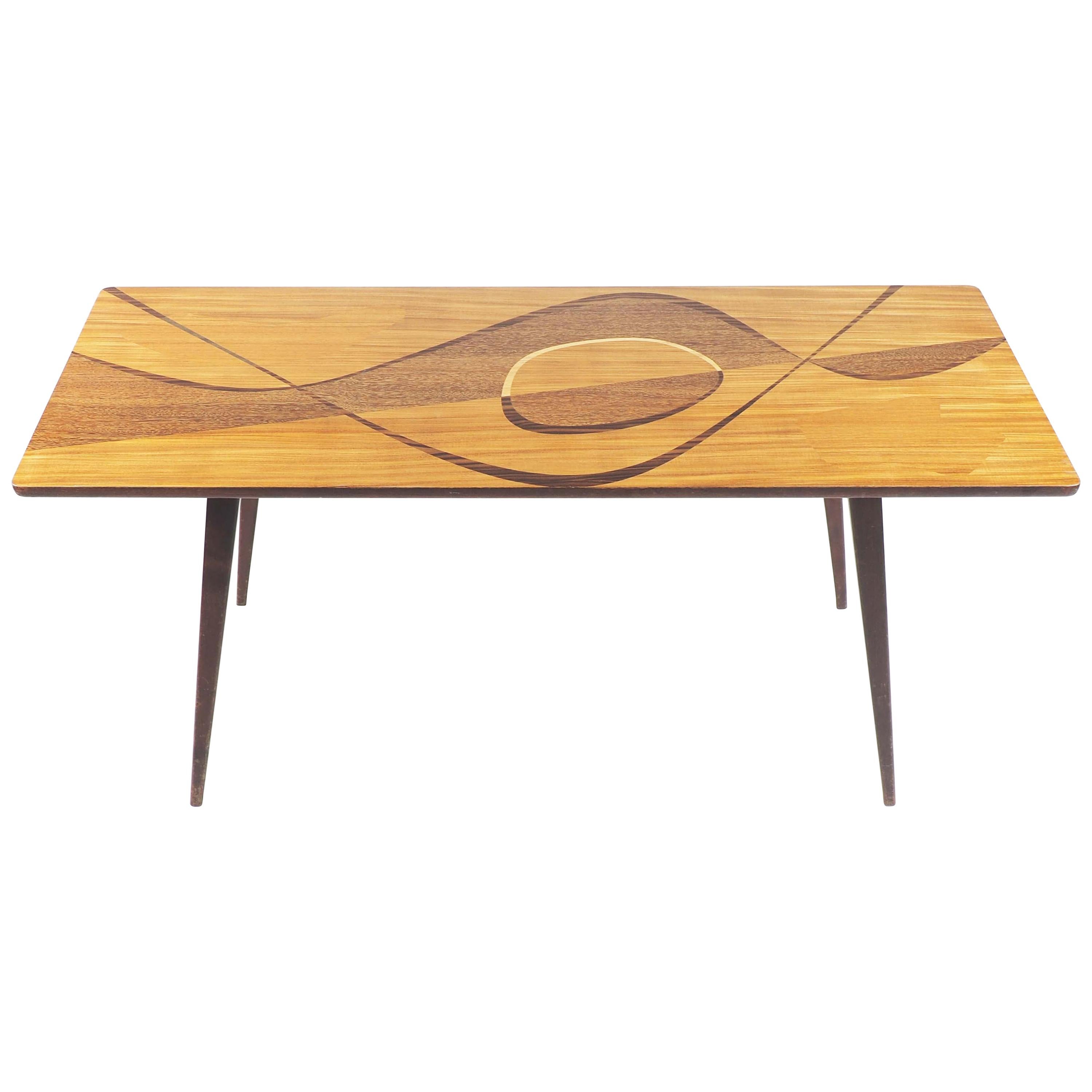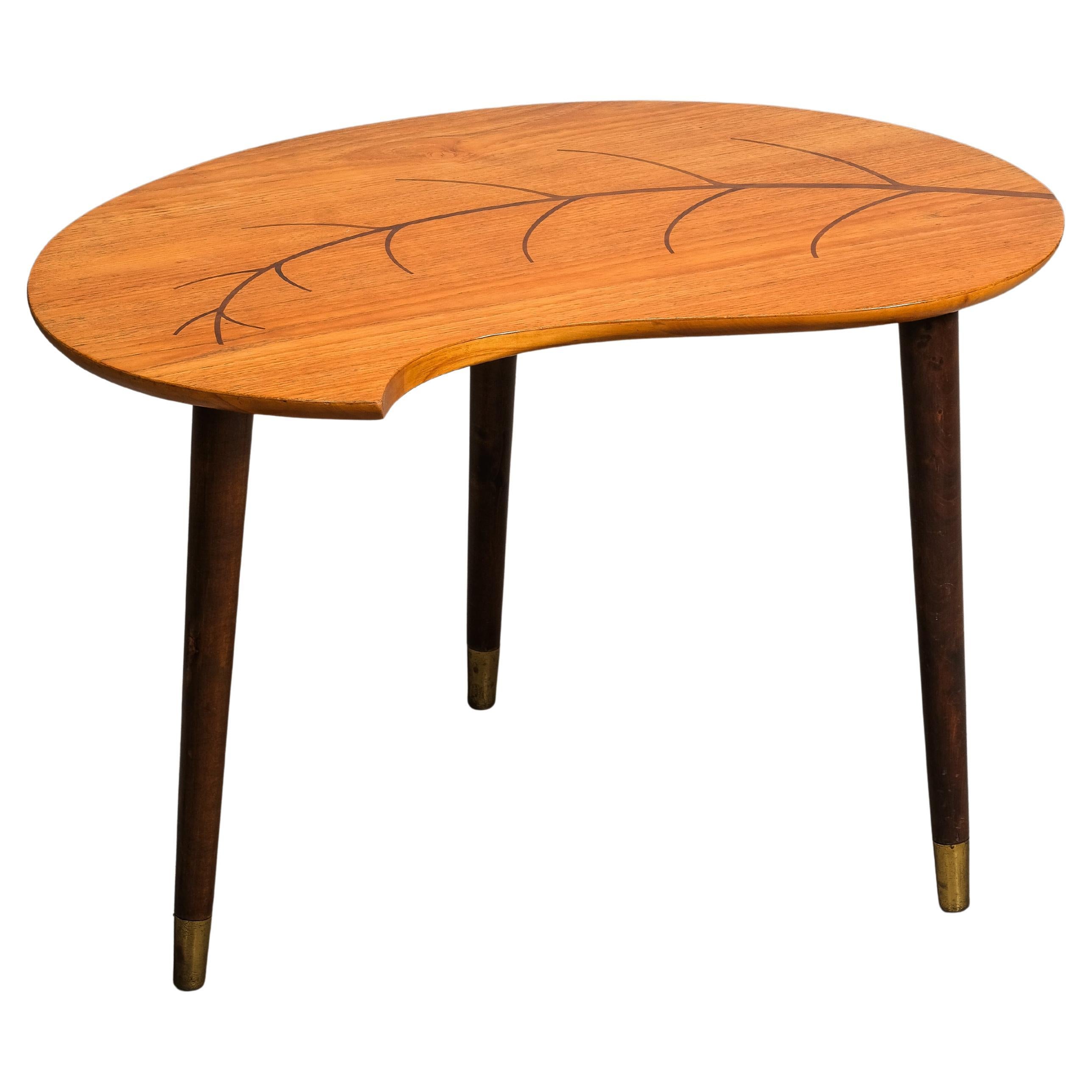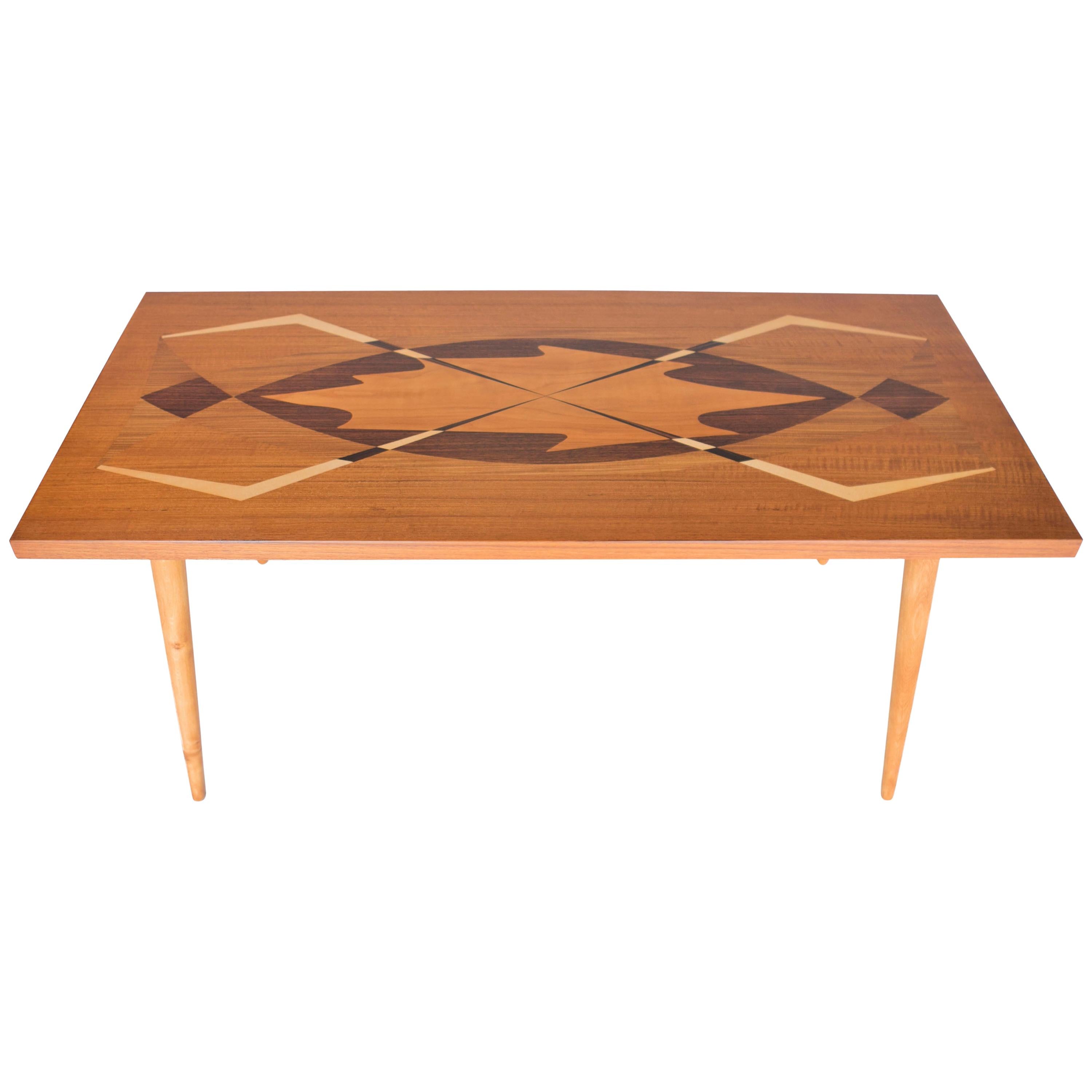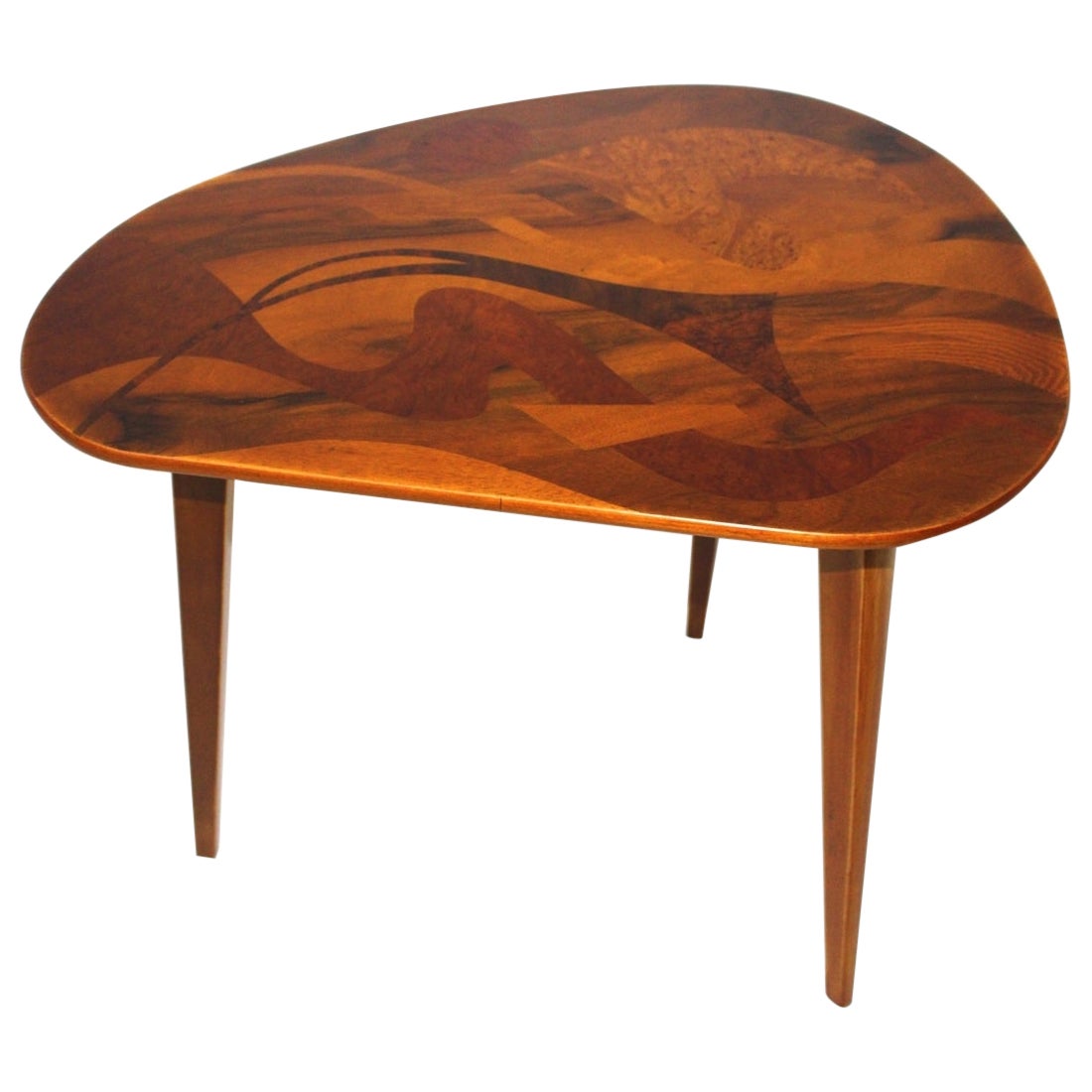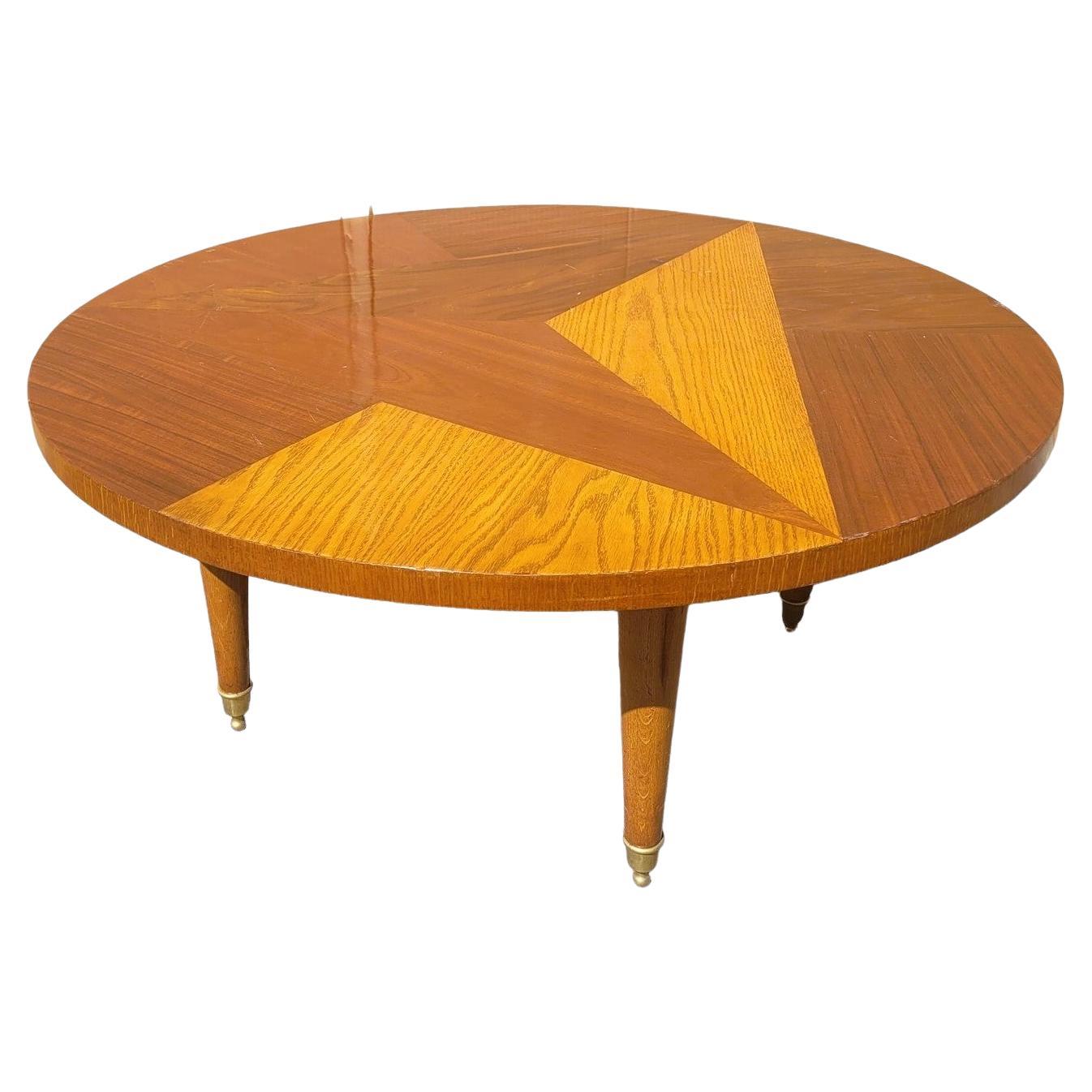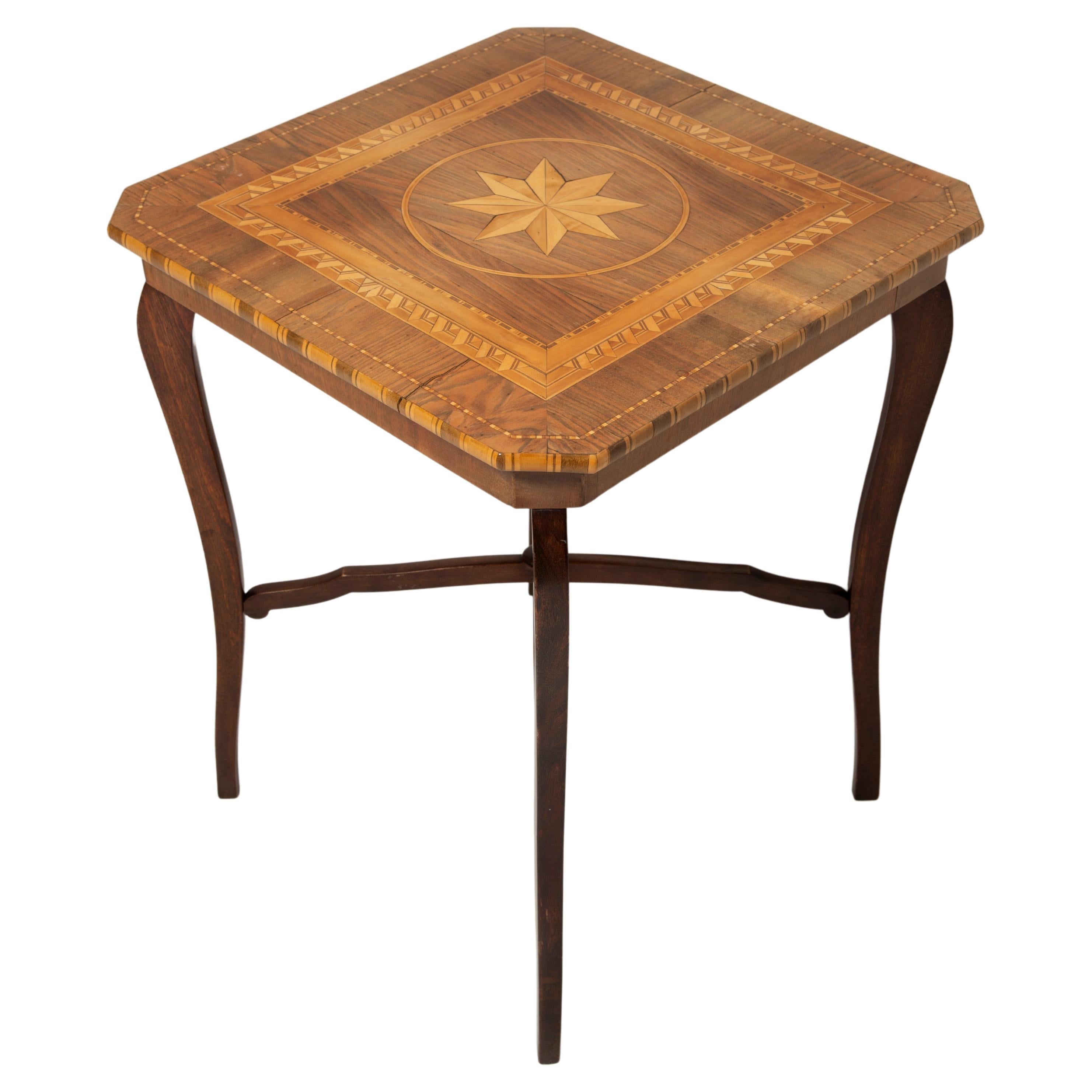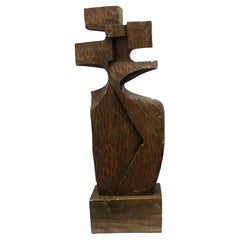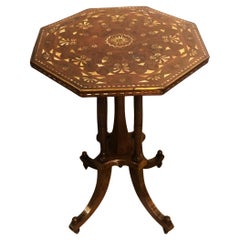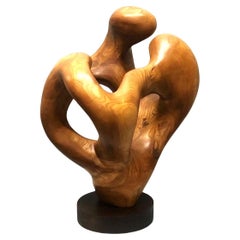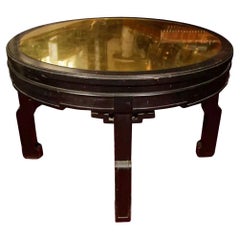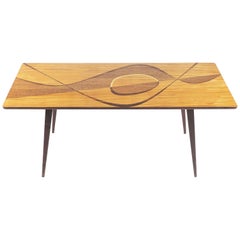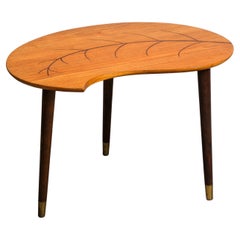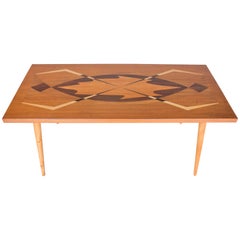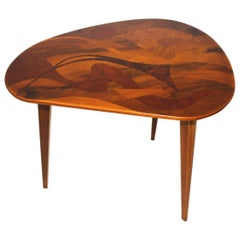Items Similar to Swedish Mid-Century Abstract Marquetry 3-Legged Coffee Table, ca. 1950s
Want more images or videos?
Request additional images or videos from the seller
1 of 12
Swedish Mid-Century Abstract Marquetry 3-Legged Coffee Table, ca. 1950s
$3,200
£2,416.51
€2,766.68
CA$4,519.24
A$4,933.92
CHF 2,586.65
MX$59,924.41
NOK 32,303.11
SEK 30,502.75
DKK 20,650.35
About the Item
Mid-Century Modernism
CoffeeSideOccasional Table
Abstract Marquetry
Sweden, ca. 1950s
ABOUT
A unique Swedish mid-century occasional side coffee table with abstract marquetry in variety of wood species. The table top has an irregular contour of a triangle with rounded corners. Hand executed. Made in Sweden, circa 1950’s. Creator unknown.
DIMENSIONS
Height: 15.5 inches
Width: 22 inches
Depth: 22 inches
- Dimensions:Height: 15.5 in (39.37 cm)Width: 22 in (55.88 cm)Depth: 22 in (55.88 cm)
- Style:Mid-Century Modern (Of the Period)
- Materials and Techniques:
- Place of Origin:
- Period:
- Date of Manufacture:ca. 1950's
- Condition:Wear consistent with age and use. We make our best effort to provide a fair and descriptive condition report. Please examine photos attentively for they are an important part of the description. Send us a message to request more details or discuss price.
- Seller Location:New York, NY
- Reference Number:1stDibs: LU2819338101342
About the Seller
5.0
Gold Seller
Premium sellers maintaining a 4.3+ rating and 24-hour response times
Established in 1993
1stDibs seller since 2017
86 sales on 1stDibs
Typical response time: 8 hours
- ShippingRetrieving quote...Shipping from: New York, NY
- Return Policy
Authenticity Guarantee
In the unlikely event there’s an issue with an item’s authenticity, contact us within 1 year for a full refund. DetailsMoney-Back Guarantee
If your item is not as described, is damaged in transit, or does not arrive, contact us within 7 days for a full refund. Details24-Hour Cancellation
You have a 24-hour grace period in which to reconsider your purchase, with no questions asked.Vetted Professional Sellers
Our world-class sellers must adhere to strict standards for service and quality, maintaining the integrity of our listings.Price-Match Guarantee
If you find that a seller listed the same item for a lower price elsewhere, we’ll match it.Trusted Global Delivery
Our best-in-class carrier network provides specialized shipping options worldwide, including custom delivery.More From This Seller
View AllAmerican Mid-Century Modernist Abstract Hand-Carved Wood Sculpture, Ca. 1950s
Located in New York, NY
American Mid-Century Modernism
Abstract Cubist Sculpture
Hand-Carved Wood
Ca. 1950s
DIMENSIONS
Height: 24.75 inches
Width: 10.5 inches ...
Category
Vintage 1950s American Mid-Century Modern Abstract Sculptures
Materials
Wood
Carlo Zen, Mother-of-Pearl & Brass Thread Inlaid Side Table, Italy, circa 1900
By Carlo Zen
Located in New York, NY
Carlo Zen
Stile Floreale - Italian Art Nouveau
Octagonal Side Table
Walnut, Mother-of-Pearl & Brass Thread Inlay
Italy, circa 1900
DIMENSIONS
Height: 28.75 inches ...
Category
Antique Early 1900s Italian Art Nouveau Side Tables
Materials
Brass
American Mid-Century Modernism, Abstract Wood Sculpture, Ca. 1960s
Located in New York, NY
American Mid-Century Modernism
Abstract Sculpture
Hand-Carved Wood
Ca. 1960s
DIMENSIONS
Height: 20 inches Width: 16 inches Dept...
Category
Vintage 1960s American Mid-Century Modern Abstract Sculptures
Materials
Wood
Art Deco Era Glass, Gold Leaf & Wood Chinoiserie Coffee Table, Circa 1940s
Located in New York, NY
Art Deco Era
Chinoiserie
Coffee Table
Glass, Wood & Gold Leaf Eglomisé
Circa 1940s
DIMENSIONS
Height: 19 in (48.26 cm)
Diameter: 29 in (73.66 cm)
ABOUT
An elegant Art Deco era roun...
Category
Vintage 1940s Asian Chinoiserie Tables
Materials
Wood
Rolph Scarlett, Modernist Abstract Composition, Guache on Paper, Ca. 1950’s
By Rolph Scarlett
Located in New York, NY
Artist: Rolph Scarletti (Canadian, 1889 – 1984)
Object: Modernist Abstract Composition
Period: Ca. 1950’s
Medium: Guache on paper, framed
Dimensions (unframed):
Height: 9-1/3”
Width: 12”
Dimensions (framed):
Height: 22-3/4””
Width: 25-3/4”
Rolph Scarlett (Canadian, 1889 – 1984) was a consummate explorer of twentieth-century abstract painting. Never afraid of trying new styles, curious and opinionated, constantly engaged with the world around him while steadfastly aware that he was on his own path and his alone, Scarlett more than once proved to be at the artistic zeitgeist of the eras in which he lived. Exposed very early on to the work of Paul Klee through a chance meeting in Europe with the artist himself, Scarlett took up abstraction with a fervor that never diminished during his long and impressive career. To create something that had never existed before: this was Scarlett’s great cause. And that is what is most obvious when you look at Scarlett’s work—you have never seen anything quite like it.
Scarlett was Canadian-born, came of age in the Midwest, and spent few important years in Hollywood, where he designed stage sets. His work from this early period echoes Klee’s use of color, his confidence in naïve, primitive forms, and his blend of abstraction and figuration. In its flat spatial qualities it prefigures the Indian Space painting of the 1940s by a decade. He moved to New York in 1933 and eventually found his first great patron at the Museum of Non-Objective Painting, directed by Baroness Hilla Rebay and art patron Solomon R. Guggenheim. Guggenheim would collect over 60 works by Scarlett for his collection, more than any other artist outside of Vasily Kandinsky and Rudolf Bauer.
As a frequent exhibitor and lecturer at the Museum of Non-Objective Painting (MNOP), Scarlett honed his sensitive feel for bodies in space and capitalized on his trademark use of bright, vivacious colors into accomplished, perfectly harmonized geometric works. However, Scarlett soon morphed these hard-edged forms into a nuanced expressionistic abstraction which, at its best, seems to be populated by dancing forms that animate the canvases. Along this way he was advised by Rudolf Bauer, the German expatriate and one of the originators of non-objective painting in the teens. Bauer had the idea for the Museum, and Rebay, his champion, had found in Solomon Guggenheim a patron for manifesting it. When Bauer emigrated just before World War II, he wanted to meet Scarlett. The two became friends, and Bauer advised Scarlett on his work over the course of many years. Even in a 1979 interview, Scarlett began to tear up as he recalled his first meeting with Bauer, a man whose work he "worshipped," describing that, "It was a touching moment for me, I’ll tell you."
Scarlett and Rebay also had a close, important relationship, one in which he bore the brunt of her sometimes condescending, if motherly, critiques and admonitions with tolerance and gratefulness. Eventually, though, he had to push back. In a letter from 1951 he writes, "I have noticed with growing amazement that during the past three years you have accepted less and less of my work—and, that same work, which you rejected has been accepted and shown in the best and largest shows all over this country."
This period—the late 1940s to the early 1950s—did in fact correspond to Scarlett’s most critical success, and to a return to the fanciful forms and characters of his pre-war work. At the same time, he found his own rhythm and complexity using a drip style similar to, though denser and more opaque than, the one made famous by Jackson Pollock, who had worked for many years at the MNOP and with whom he shared common influences. In 1949 he had a very well received solo show in 1949 at the Jacques Seligmann Gallery, reviewed very favorably in The New York Times: "The impression made by these paintings is one of originality and strength." He was also included in a juried show "American Painting Today" at the Metropolitan Museum of Art in 1950 and in the Whitney Annual of 1951. The curator for the Whitney show in fact bypassed a selection of Scarlett’s careful geometrics in favor of a new "lyrical" drip painting—one which he describes as having had "a helluva good time" making.
Rebay articulated her loss of control over Scarlett very keenly in one of her last official letters to him: "So your way ended in the horrid jungle it is in now; even a Mr. Pollock’s smearage was not bad enough for you to have a try at; and betraying yourself, you betrayed art and my faith in you, and my present disgrace by my failure to foresee such an outrageous possibility—since you even paint objectively now."
Yet, despite the fact that he was moving in his own direction when the change in leadership took place at the Museum of Non-Objective Painting and Rebay was forced out as director, Scarlett was hit hard. He understood this change rightly as a betrayal by the establishment. Scarlett was a unique individual and soul, and was affected personally and philosophically by the idea that the movement with which Scarlett had aligned his talents seemed to disappear overnight, and his life’s work rendered valueless.
Without the Museum’s support, Scarlett decided eventually to move to the artists’ community of Shady, New York, just outside of Woodstock. He had occasional shows throughout the years, but mostly settled down to regional obscurity. He began making jewelry, which had been his first trade, and it was following a show of his jewelry in 1975 at the Jaro Gallery, that he was rediscovered by Samuel Esses, and his wife Sandy.
Samuel Esses was a successful businessman and an avid collector. He always sought out that which was unusual and, like Scarlett, was ahead of his time in many ways. For example, in 1979, Sam became enthralled with the early graffiti appearing on the New York subway trains. With the sole goal of preserving these groundbreaking yet short lived works of art he was inspired to create "The Esses Studio," a painting warehouse and workshop for graffiti artists to work in a studio, collaborate, and paint on canvas. The biggest names of graffiti writing participated—Futura, Crash, Dondi, Zephyr, and Daze to name a few. The project was well received and provided critical validation at an important time for this alternative form of abstraction to be recognized by the established art world. The success of the "Esses Studio" helped fuel an alternative fire that would propel gallerists and curators to acknowledge other street artists and provide a foundation of acceptance for the early careers of Keith Haring and Jean-Michel Basquiat. It is not a stretch to say that what Esses saw in the graffiti art of the 1970s was very similar to what he saw in 1950s-era Scarletts—something raw, honest, and melding many twentieth century influences into one unique form. Inspired by the importance of the collection and the passion of the collector, Weinstein Gallery...
Category
Vintage 1950s Canadian Mid-Century Modern Paintings
Materials
Paper
American Contemporary Abstract Brutalism Sculpture in Iron, Wood & Tin, c. 1970s
Located in New York, NY
American Contemporary
Abstract Brutalism
Abstract Sculpture
Iron, Wood & Tin
c. 1970s
DIMENSIONS
Total height: 48 inches
Sculpture height: 37.25 inches ...
Category
Vintage 1970s American Mid-Century Modern Abstract Sculptures
Materials
Iron, Tin
You May Also Like
Coffee Table with Inlaid Wood from Sweden, 1950s
Located in Goteborg, SE
Coffee table with inlaid wood in graphical patterns. With our knowledge about Swedish furniture very likely made in Tranås. A town well known f...
Category
Vintage 1950s Swedish Scandinavian Modern Coffee and Cocktail Tables
Materials
Teak, Elm
Mid-Century Swedish Organic Form Teak Coffee Table with Inlay, 1950s
Located in Karis, Nyland
A Swedish mid-century coffee table with a leaf-shaped teak top, decorated with an intarsia inlay in the form of a branch and leaves. The organic kidney-shaped form reflects the playf...
Category
Vintage 1950s Swedish Mid-Century Modern Coffee and Cocktail Tables
Materials
Wood, Teak
Swedish Modern Coffee Table with Exotic Wood Inlay, Sweden, 1950s
Located in Los Angeles, CA
Swedish modern coffee table with exotic wood inlay, Sweden, 1950s
This is a very special Swedish coffee table with exotic inlaid wood in...
Category
Mid-20th Century Swedish Scandinavian Modern Coffee and Cocktail Tables
Materials
Birch, Elm, Fruitwood, Rosewood, Teak
$1,800 Sale Price
20% Off
Mid-Century Modern Vintage Wood Sofa Table Coffee Table, 1950s Austria
Located in Vienna, AT
Mid-Century Modern Organic vintage coffee table or sofa table from wood with stunning motifs designed and manufactured in Austria 1950s.
A...
Category
Vintage 1950s Austrian Mid-Century Modern Coffee and Cocktail Tables
Materials
Wood
Marquetry Coffee Table, Art Deco, 20th Century
Located in MARSEILLE, FR
Large round coffee table in wood marquetry, playing on symmetry and color, art deco 4 legs with bronze ends
Usual wear to varnish
Height: 45cm
Diameter 100cm
Category
20th Century French Art Deco Coffee and Cocktail Tables
Materials
Wood
Mid-Century Modern Coffee Table, Vintage, Art Deco, Star Marquetry, 1960s
Located in 05-080 Hornowek, PL
Coffee table from the 1960s. Amazing shape and top of the table - 100% Art Deco style. It was manufactured in France. The table was made of walnut wood, it was fully and professional...
Category
20th Century French Mid-Century Modern Tables
Materials
Beech, Walnut
More Ways To Browse
3 Legged Table
Vintage 3 Legged Table
3 Legged Coffee Table
Agate Drink Table
Atomic Coffee Table
Audoux Minet Coffee Table
Bamboo And Tile Table
Bentwood Round Table
Biomorphic Rattan Coffee Table
Blue Lucite Coffee Table
Bodega Coffee Table
Bog Oak Table
Brass Onyx Round Tables
Brass Scalloped Coffee Table
Burl Slab Table
Butcher Coffee Table
Carlo De Carli Spider Table
Chain Link Coffee Table
